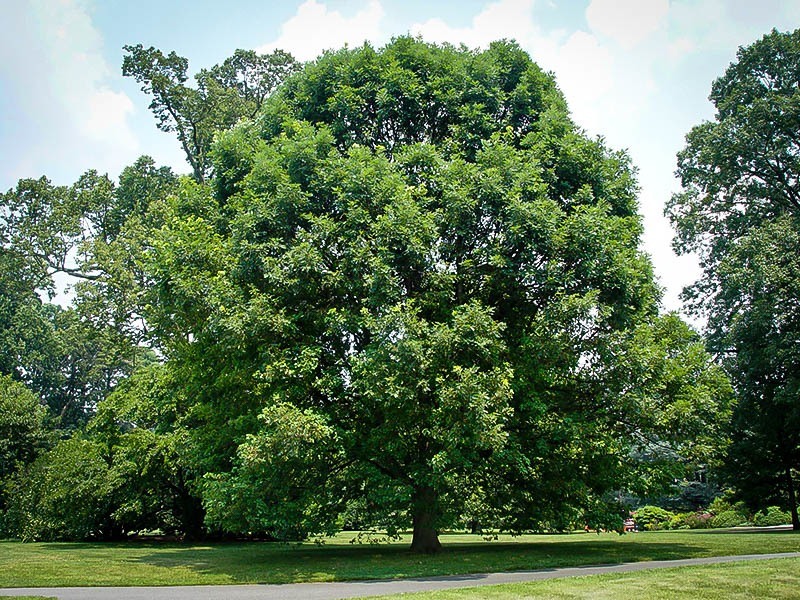White oak (Quercus alba) is a common oak tree across the eastern United States. It can be found in both the Upper and Lower Peninsulas in Michigan (though less commonly in the Upper Peninsula).
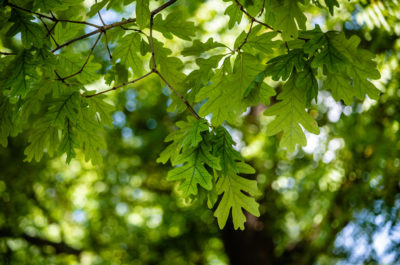
White oak leaves. Photo by Michael W. May | Flickr
How To Identify
White oak is most easily distinguished by its rounded tips to its leaf lobes, which is unlike red oak with its pointy tipped lobes. The leaves are arranged alternately, are simple, and are lobed. Leaves are about 5–9 inches long. White oaks have large, rounded acorns, which are produced every 4 to 10 years. Acorns are about 1″ long, with a rough, scaly cap with a stalk. Read more on white oak and its identification on page 20 of this field guide: Trees of Ohio Field Guide.
Growing Conditions
White oak is most often found in upland woods and areas with moist, well-drained soils. Once mature, white oak is on average between 80 to 100 feet tall. White oak is moderately tolerant to shade, and seedlings with full sun for at least part of the day are the most successful.
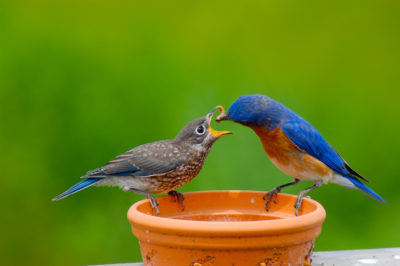
Eastern Bluebird. Photo by Dave Poortvliet | APA
Oaks: Important Host Plants
In general, oaks are host plants for at least 452 species of butterflies and moths! That means that oaks are a suitable plant for these butterflies and moths to lay eggs and for the caterpillars to munch on oak leaves. And what eats caterpillars? Birds, of course! Caterpillars are a very important food source for birds, especially during the breeding season when they feed their young. Caterpillars are high in fats and proteins, and their soft, squishy bodies make them easy to feed to nestlings (as opposed to hard-bodied beetles, etc.). Oaks are essential not only to birds and butterflies but also to many other wildlife species. The acorns produced by oaks — considered “hard mast” — are an important food source for Wild Turkey, Blue Jay, Wood Duck, white-tailed deer, squirrels, mice, and other critters.
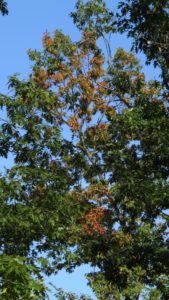
Wilting oak leaves with early onset of the disease. Photo: MSU Extension
Oak Wilt
Watch for this exotic disease, and don’t prune your oaks in summer!
January through March is a great time of year to inspect trees in your yard or on your land for disease or insect damage. Tree pruning — for example, branches that might impact utility lines — should be done before April. Oak wilt disease is a concern and is most easily spread between mid-April to August; this is the season to avoid cutting and wounding oaks. Oak wilt is an exotic disease that is causing widespread damage to oaks in Michigan, causing oak trees to die. If oak wilt is introduced to a stand of oaks (through cuts or damage to oak bark), the disease will kill most of the oaks, and treatment is expensive. During the growing season (when there are green leaves on the trees), look for rapid wilting and loss of leaves, especially near the tops of oak trees. Once infected, an oak may die within a few weeks. Red oaks are more susceptible to this disease, but it also impacts white oaks, and the spread should be prevented as much as possible. MSU Extension has a helpful fact sheet on oak wilt and how to prevent its spread.
Oaks are truly incredible resources for a diversity of wildlife, pollinators, and birds. If you can choose just one tree species to plant in your yard, an oak would be at the top of our recommended list!
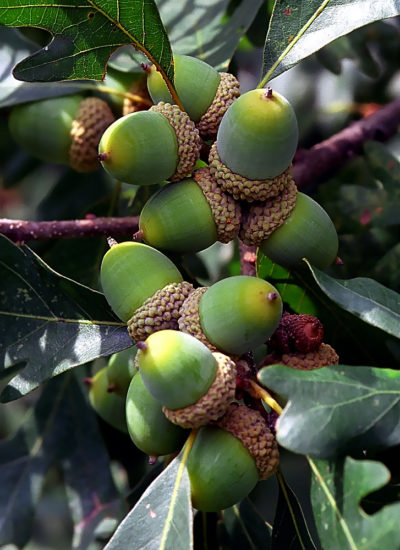
White oak acorns. Photo by David Ohmer | Flickr
Additional Reading and Resources
- Bird-Friendly Plants: Learn more about why native plants are so critical for birds, and check out Michigan Audubon’s resources on native plant landscape design, native plant selection (i.e., which plants are great for birds!), and more: https://www.michiganaudubon.org/bfc/bird-friendly-plants/
- Dr. Doug Tallamy, a researcher at the University of Delaware, leads the field in documenting connections between plants, insects, and birds. His latest book (to be released in March 2021) will focus entirely on oaks and their critical importance! Watch for this one: “The Nature of Oaks: The Rich Ecology of Our Most Essential Native Trees.”
- Easy steps to get started at home with native plants: Homegrown National Park: Five Easy Steps for Beginners. Also, check out this recently recorded webinar, from Georgia Audubon, with researcher Dr. Doug Tallamy: Nature’s Best Hope.
- Keep tabs on your local environmental organizations or nature centers. Many organizations offer webinars about native plants and native landscaping, which may spark your interest or help answer questions you may have! A great upcoming webinar series hosted by Woldumar Nature Center in Lansing will cover themes related to native landscaping (native plants for food in urban settings, native shrubs, and upkeep of native gardens), with native landscape designer Christopher Hart. Virtual Native Garden Workshop with Christopher Hart
- Michigan Audubon’s own Bird-Friendly Communities Lunch & Learn webinar series offers a free, monthly presentation on topics ranging from native plants to supporting Purple Martin to reducing hazards to birds. The webinars are monthly on the second Tuesday, from 12 to 12:45 p.m. Bird-Friendly Communities Webinar Series

